Research
Modification of photosynthetic and stress tolerance mechanisms to produce novel crops with high tolerance to environmental stresses
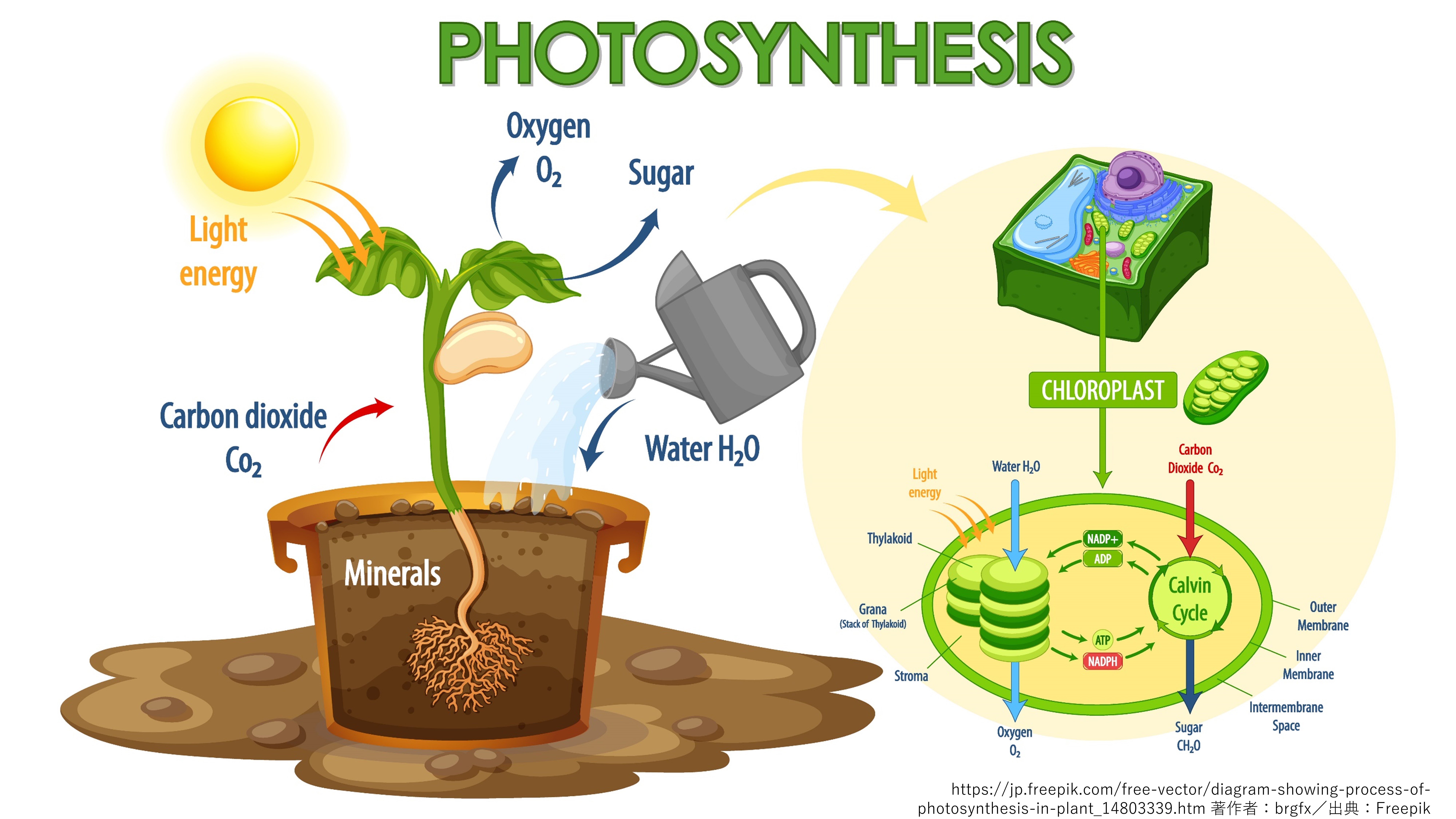
Photosynthesis is a process that converts inorganic carbon into organic
compounds like starch and sugar, utilizing energy from sunlight and other
sources. This process involves the breakdown of water, releasing oxygen
as a byproduct. On our planet, photosynthesis occurs in land plants, algae,
and cyanobacteria.
The quantity of starch and sugar produced by crops like rice varies with
their photosynthetic activity, directly affecting yields. Enhancing the
photosynthetic capacity of crops can consequently lead to increased agricultural
output.
Environmental shifts, notably global warming, deteriorate arable landscapes,
exacerbating the pressing issue of dwindling food productivity. Amidst
this challenge, plants exhibit distinct photosynthetic strategies, encompassing
C3 photosynthesis in rice and wheat, C4 photosynthesis in maize and sugarcane,
and Crassulacean Acid Metabolism (CAM) photosynthesis in cactus and aloe.
Predominantly, major crops adhere to C3 photosynthesis (C3 plants). Yet,
nearly 40% of the world's arable land lacks sufficient precipitation to
sustain these crops, exposing essential food sources to unrelenting environmental
strains. Conversely, C4 and CAM photosynthetic plants exhibit robust resilience
to stressors like drought and high temperatures.
Hence, envisaging the integration of C4 and CAM photosynthesis into C3 crops,
such as rice, holds the promise of yielding resilient cultivars that endure
environmental adversities with tenacity.
Moreover, Earth hosts a multitude of plants adept at enduring environmental
pressures, including salt, drought, and cold tolerance. Our attention extends
to deciphering the stress tolerance mechanisms within these plants. Through
comprehensive utilization of physiological and molecular biological techniques,
we delve into uncovering the intricate mechanisms empowering their resilience
in challenging habitats.
Towards Achieving a Decarbonized Society
Biomass energy, a carbon-neutral and renewable resource primarily derived
from crops abundant in sugars, starches, oils, and fats, has gained substantial
momentum. The call for biomass energy has surged in recent times, with
projections by the IEA (2021) indicating its potential to encompass around
20% of the overall energy demand by 2050. As we strive to materialize a decarbonized society by curbing carbon emissions,
the development of energy-efficient crop resourcesassumes paramount significance.
Our laboratory delves into resource crop development with an energy focus,
integrating photosynthetic conversion and environmental stress response
mechanisms. While carbon-neutral energy research, particularly in bioethanol
and biodiesel, flourishes overseas, Japan remains relatively unexplored
in this regard. Our pursuit involves cultivating crops proficient in the swift synthesis
of photosynthetic products, notably starch - a vital precursor for bioethanol
and biodiesel production. Collaborative opportunities with energy field
experts are warmly welcomed.
Key Plant Species Studied
(1) Mesembryanthemum crystallinum L. – the common ice plant
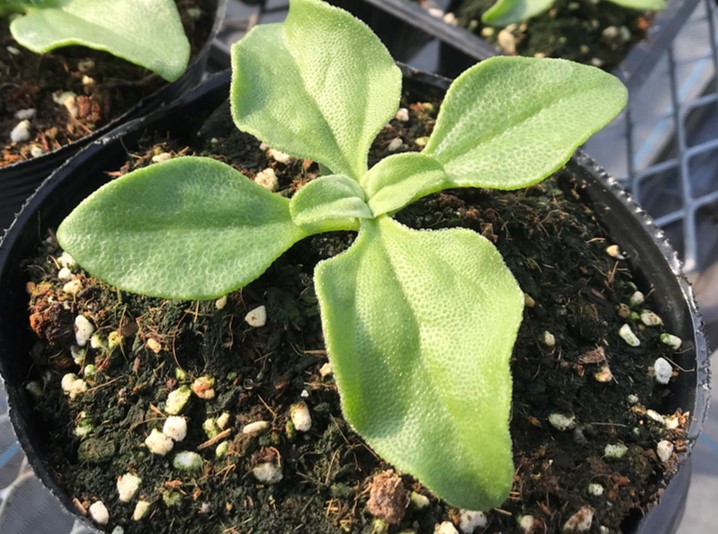
The common ice plant, an annual herb indigenous to South Africa, thrives
even in the presence of sodium chloride (NaCl). Notably, when subjected
to NaCl concentrations equivalent to seawater (400 mM), this species transitions
its photosynthetic type from C3 to CAM. Remarkably, it flourishes in the
face of 100 mM NaCl (approximately 1/4 of seawater), a level lethal to
other crops. This halophyte's resilience to salt renders it an exceptional
saline-tolerant plant. Given reports of oil and fat accumulation in the
seeds of other halophytes (Yanxia, 2010), the potential for oil and fat
accumulation in the ice plant seeds has also been investigated.
Research on this species began in earnest in the 1970s, culminating in
the recent elucidation of its genome sequence (Shen et al., 2022). In line
with this advancement, our laboratory has independently established its
genome sequence, facilitating molecular biological investigations of the
ice plant with unprecedented precision.
(2) Eleocharis vivipara - Umbrella Hairgrass

Eleocharis vivipara, stands as an amphibious plant within the Cyperaceae
family. It exhibits a remarkable adaptability, undergoing reversible shifts
between C3 and C4 photosynthesis with changes of its growth environment.
Strikingly, this species lacks leaf blades, with the culm serving as its
primary photosynthetic organ. In the terrestrial growth, the culm has large
bundle sheath cells, abundant in chloroplasts and mitochondria. Surrounded
by fenestrated phloem cells arranged radially, a unique Kranz-type leaf
structure akin to C4 plants emerges. Conversely, submerged culms unveil
extensive, well-developed leaf fleshy cells on their epidermal inner surfaces.
Remarkably, the size of bundle sheath cells in this aquatic form diminishes
significantly, containing only a few small chloroplasts and mitochondria.
Further adding to its scientific value, Eleocharis offers distinct photorespiration
traits in its terrestrial and aquatic forms. This trait renders it an invaluable
model for scrutinizing differences in the tissue-specific expression of
photorespiratory enzymes in C3 and C4 plants. It also serves as a platform
to delve into the regulatory mechanisms and physiological significance
of photorespiration.
(3) Umbrella Plant (Cyperus alternifolius L.)
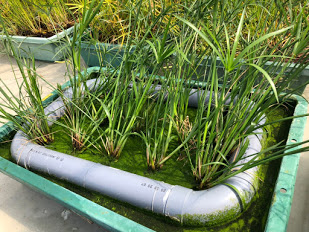
The umbrella plant is a perennial herb from the Cyperaceae family, and
it is native to Madagascar. In our laboratory, Agata and Song (2002) demonstrated
that this species improves water quality in eutrophic water bodies, showcasing
its value for environmental purification. Moreover, this species possesses
a strong ability to absorb nutrients like phosphorus and nitrogen (Kumwimba
et al., 2017), which makes it a promising source of biomass.
Furthermore, this species also absorbs and accumulates harmful substances
such as Cr and Pb. The stem of plant contains a significant amount of polysaccharides
like starch, which could make it a potential source of bioenergy material.
In previous studies, we estimated the amount of biogas produced by this
species, revealing its potential as a biofuel precursor due to its high
gasification efficiency and low ash content (Tanaka, 2016).
(4) Rice (Oryza sativa L.)
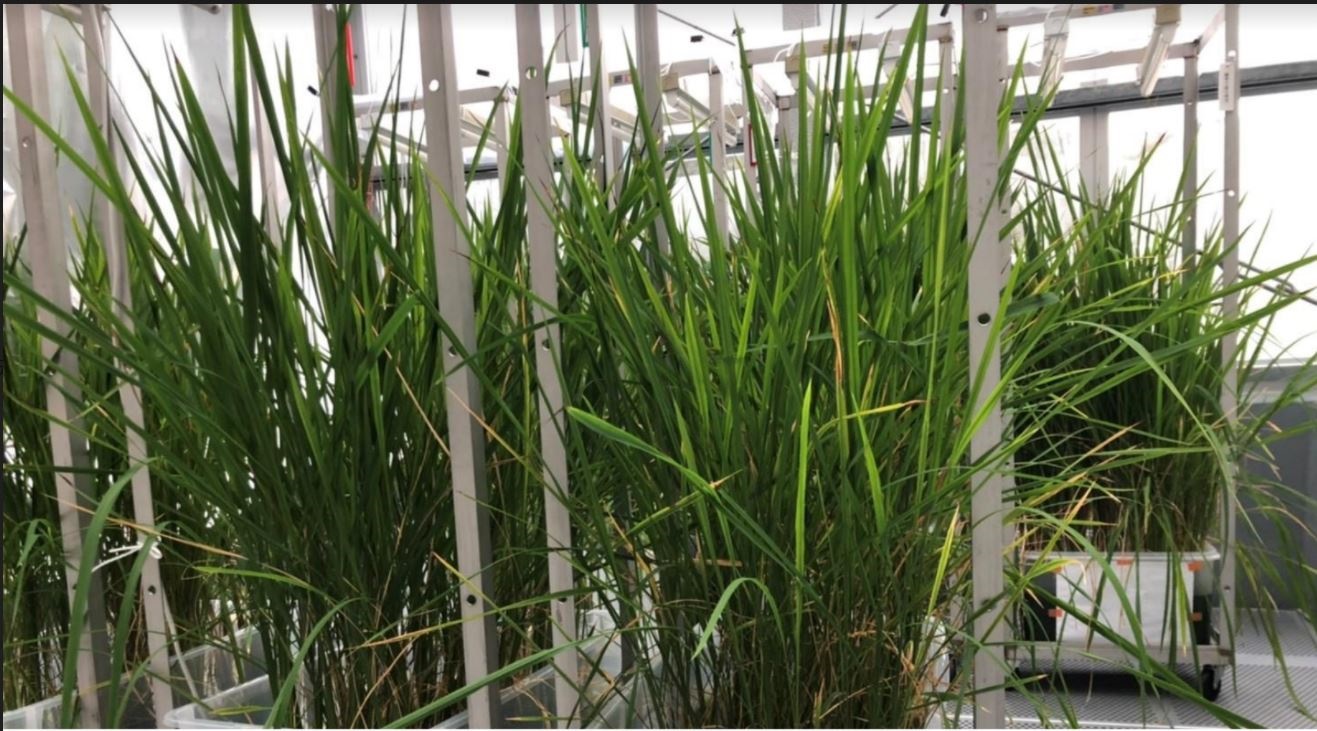
Rice (Oryza sativa L.) is a plant that belongs to the Poaceae family and
stands as one of the world's three primary crops. Its production has seen
a rise owing to the population growth in Asia. The common practice of using
chemical fertilizers, especially Nitrogen, to boost yields has led to issues
of environmental pollution and economic strain. Achieving high yields with
minimal fertilization is a key goal.
・Introducing CAM Photosynthesis to C3 Plants
CAM plants exhibit structural resemblances with C3 plants, raising the prospect of endowing C3 plants with CAM-like photosynthetic processes. This hypothesis fuels our research, where we delve into the feasibility of this idea and investigate a molecular system governed by transcription factors to regulate gene expression levels. Our objective is to validate this concept and generate crops endowed with robust tolerance to environmental stressors. CAM photosynthesis accomplishes a "temporally separation of carbon
fixation" by absorbing CO₂ in the morning and converting it into malic
acid during the night.Previous studies have hinted at the existence of genes responsible for
this "temporally separation of carbon fixation" in CAM photosynthesis,
which constitutes our current research focus. These genes fall under the
category of "clock genes" (Cushman et al., 2008). In our investigation,
we adopt a unique strategy employing dimethyl sulfate (DMS) to pinpoint
binding sites for transcription factors, which in turn control the expression
of genes linked to CAM photosynthesis. Our objective lies in identifying
the transcription factors that govern the expression of genes tied to CAM
photosynthesis using this methodology.
(Responsible for this study) M2 Kondo, Munaoka, M1 Masako, Takagi, B4 Kishimoto
・Exploring Mechanisms of C3-C4 Photosynthesis Transition in Response to
Environmental Changes

C4 plants are believed to have gradually evolved from their C3 counterparts
over an extended timeframe. The shift in plant photosynthetic patterns
is thought to have been primarily influenced by the decline in atmospheric
CO2 concentration that commenced roughly 1.4 billion years ago. However,
the intricate evolutionary mechanisms underlying this transition remain
shrouded in uncertainty, leaving several questions unanswered. This study delves into the evolutionary progression from C3 to C4 photosynthesis,
employing the amphibious plant Eleocharis vivipara. This species showcases distinct photosynthetic modes in terrestrial and
aquatic forms, practicing C4 in the former and C3 in the latter. Earlier
research has indicated the involvement of plant hormones in this photosynthetic
conversion. Our research aims to comprehensively identify sets of genes
with varying expression levels in response to alterations in cultivation
conditions and plant hormone levels within specified treatment durations,
utilizing RNA-Seq analysis.
(Responsible for this study) D2 Sato, M1 Shigemasa
・Development of a method for introducing C4-type photosynthesis into C3 plants
Efforts to introduce the C4 photosynthetic metabolic mechanism into C3
plants have been attempted by many researchers, but none have been successful
to date (Taniguchi et al., 2008; Miyao et al., 2011). One reason for this
is the difference in leaf structure and metabolic mechanisms between C3
and C4 plants. Notably, the fact that C4 plants possess a Kranz-type leaf
structure and the process of its formation remains unclear, makes the transition
of C3 plants to C4 challenging. In our lab, we are conducting research
to identify the genes that promote the formation of the Kranz-type leaf
structure. We believe that by introducing these genes, major crops like
rice, which are C3 plants, can adopt the Kranz-type leaf structure, and
we continue our research towards this end.
(Responsible for this study) D2 Sato, M1 Shigemasa
・Development of High-Yielding Rice Varieties Under Low Nitrogen Conditions
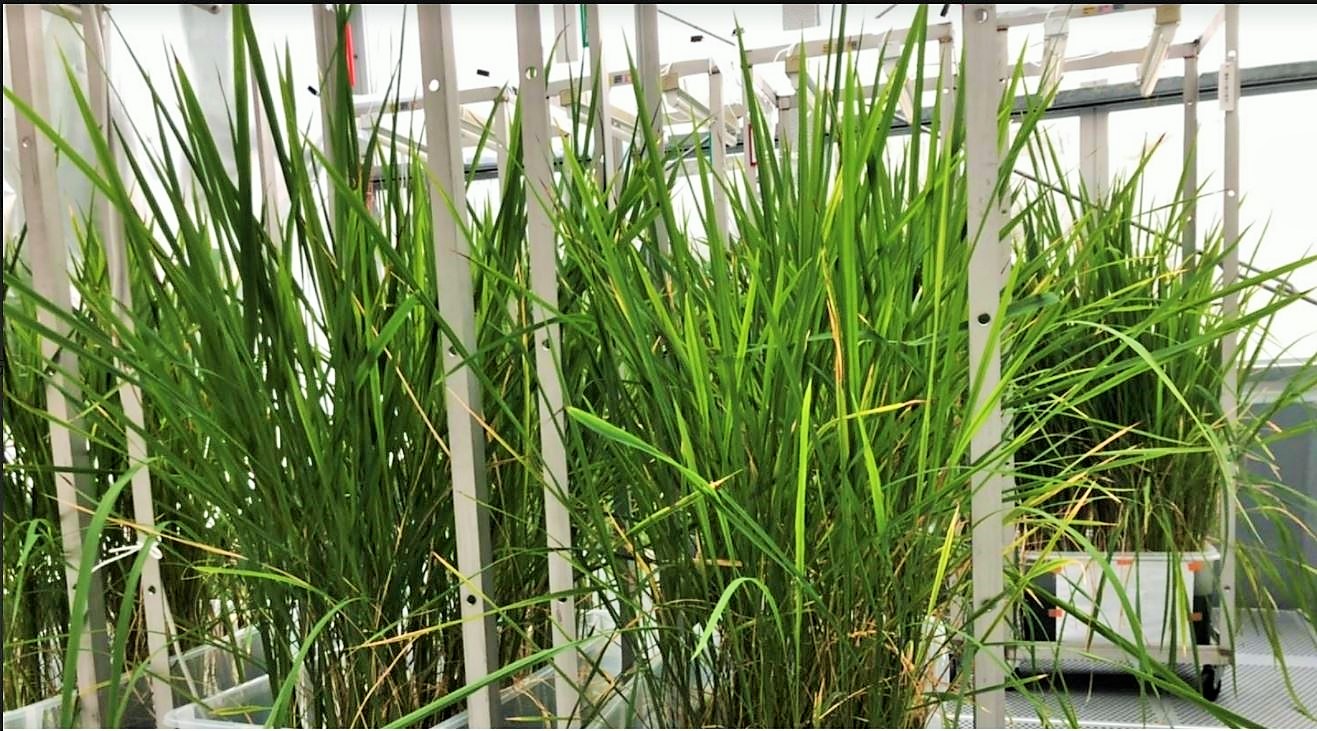
Nitrogen compounds present in chemical fertilizers, essential for increasing
crop yields, have raised concerns owing to their runoff into rivers and
subsequent water pollution. Furthermore, in developing nations poised for
population growth, the costs associated with fertilizers frequently curtail
their effective use, resulting in limited potential for yield enhancement.
In response to these challenges, and with the aim of sustaining yield levels,
the creation of novel crop varieties capable of maintaining robust photosynthetic
capacity in low-fertilizer settings becomes imperative. To realize this
objective, we are dedicated to generate rice varieties that can achieve
elevated yields under conditions of limited nitrogen availability. Our research delves into the epigenetic regulation of enzyme genes tied
to photosynthesis, influenced by nitrogen.Additionally, we are actively conducting experiments employing genome editing
as one of the techniques for transforming traits.
(Responsible for this study) M2 Utsunomiya, M1 Liu
・Factors Controlling Shoot Re-differentiation in the Common Ice Plant

The ice plant presents challenges in genetic analysis due to the absence
of established effectivetransformation techniques. One contributing factor is the inability of cultured cells to undergo
shoot re-differentiation. To address this issue, we are actively investigating
culture conditions capable of inducing shoot re-differentiation from calli
originating from excised plant tissues (explants). Additionally, we are
engaged in gene expression analysis pertaining to the re-differentiation
process. Through these approaches of research, our aims encompass identifying the
underlying causes of shoot re-differentiation deficiency, establishing
effective re-differentiation methodologies, and endeavoring to generate
transformed ice plant variants.
(Responsible for this study) M1 Kanda
・Developing Transformation Techniques for the Common Ice Plant

Full establishment of efficient transformation methods for the ice plant
remains elusive. Our focus centers on the floral dip method, which has showcased efficacy in transforming various plant species. This
approach involves the direct introduction of genetic mutations into plant
buds through infection with Agrobacterium tumefaciens. While employing
the floral dip method, we have accomplished the production and selection
of transformants.
(Responsible for this study) M2 Ginger
・Unraveling Salt Tolerance and C3-CAM Conversion Mechanisms in Ice Plant

The ice plant demonstrates remarkable "salt tolerance," displaying improved growth when subjected to varying levels of
NaCl (50-200 mM, equivalent to 1/10 to 1/2 of seawater). While research
on salt tolerance has been carried out in other halophytes such as quinoa
and Suaeda, which share analogous traits, the molecular biology mechanisms
underpinning this phenomenon remain elusive. Our research aims to know
the positive role of NaCl in the ice plant growth. We delve into research
focused on photosynthesis, mitochondrial ATP synthesis, and the cell cycle.
Furthermore, this species can shift its photosynthetic type from C3 to
CAM under the same NaCl concentration as seawater. CAM plants that can
adjust their photosynthetic types in response to the environment are termed
"facultative CAM plants." However, the fundamental mechanisms driving the CAM conversion
remain to be fully elucidated. This research theme integrates bioinformatics
to shed light on the salt tolerance mechanism and the conversion of C3-CAM
photosynthesis. We explore these aspects from the perspectives of the genome,
epigenome (DNA methylation), and transcriptome.
(Responsible for this study) D2 Sato, B4 Mori
・Elucidation of soil microbe-plant interactions enabling natural cultivation
One of the sustainable agricultural methods is "natural cultivation,"
which does not use chemical fertilizers and effectively utilizes beneficial
soil microorganisms for plant growth. Although it is empirically known
that soil microorganisms thrive in organic matter and produce nutrients
for plants, the scientific basis remains unclear.
In this research, we will comprehensively analyze the species of microorganisms
present in the soil under conventional farming practices and natural cultivation
using metagenomic analysis. Ultimately, we aim to identify the microorganisms
that are beneficial for natural cultivation.
(Responsible for this study) D1 Sasahara
・Investigation into Cultivation Establishment and Identification of Beneficial Components in Moringa
Moringa oleifera, a woody plant indigenous to India, belongs to the Moringa
genus within the Moringaceae family. All parts of the plant, including
leaves, tubers, seeds, bark, pods, flowers, and fruits, are harnessed for
various purposes. Moringa has been found to encompass various functional
compounds, including 48 types of fatty acids and esters, 56 types of hydrocarbons,
37 types of alcohols, 32 types of ketones, and 69 types of aldehydes, among
others.
Noteworthy effects have been reported, spanning from cardiovascular system
support to tumor suppression, antipyretic properties, anti-inflammatory
capabilities, antiepileptic benefits, anti-ulcer attributes, antispasmodic
qualities, diuretic actions, hypotensive potential, cholesterol-lowering
abilities, antioxidant prowess, antidiabetic effects, liver protection,
antibacterial attributes, antifungal properties, and more.
Since 2013, our efforts have been dedicated to establishing cultivation
and refining processing methods to enhance the consistent supply of these
beneficial components. Cultivation trials commenced in Sanuki City, Kagawa Prefecture, in 2019,
and extended to Karatsu City, Saga Prefecture, in 2020. We warmly welcome collaboration opportunities for advancing this research
initiative.
(Responsible for this study) M2 Joshua
・Investigating Potential of Ice Plant as a Functional Vegetable

The common ice plant (Mesembryanthemum crystallinum L.), an annual herb
native to South Africa, harbors valuable constituents such as proline and
pinitol. Despite its broad commercial availability under various trademarks
nationwide, these variants are of the wild type. Notably, our exclusively
developed registered cultivar, KA-I243, stands out as the exception. Our goal is to elevate the ice plant's standing to that of a functional
vegetable.This endeavor encompasses the creation of variants enriched with heightened
functionality and the establishment of cultivation techniques aimed at
magnifying the presence of health-enhancing components
.
(Responsible for this study) M1 Dennis
・Water Purification Utilizing Cyperus alternifolius

Cyperus alternifolius L., a member of the Cyperaceae family, exhibits
a remarkable ability to generate biomass and absorb nutrients through its
roots from polluted water. Our research focus on the development of a method
for removing sodium hypochlorite using Cyperus alternifolius. As part of
this endeavor, we are investigating the threshold concentration of sodium
hypochlorite that Cyperus alternifolius can endure. Moreover, leveraging
the plant's exceptional capacity for nutrient absorption and its potential
role in mitigating eutrophication, we are cultivating Cyperus alternifolius in nutrient-enriched water and
assessing water quality and growth rates.
Our research seeks to unveil the intricate interaction between Cyperus
alternifolius and the surrounding bacteria in enriched nutrient environments,
with a primary focus on symbiotic bacteria. Through this exploration, we aim to elucidate the underlying mechanism driving accelerated growth
and absorption of nutrients from polluted eutrophication water.
(Responsible for this study) D2 Sato, M2 Joshua, M1 Dennis, B4 Tsuru
